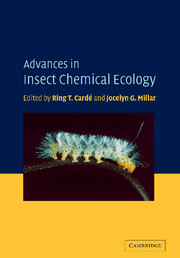Book contents
- Frontmatter
- Contents
- List of contributors
- Preface
- 1 Phytochemical diversity of insect defenses in tropical and temperate plant families
- 2 Recruitment of predators and parasitoids by herbivore-injured plants
- 3 Chemical ecology of astigmatid mites
- 4 Semiochemistry of spiders
- 5 Why do flowers smell? The chemical ecology of fragrance-driven pollination
- 6 Sex pheromones of cockroaches
- 7 A quest for alkaloids: the curious relationship between tiger moths and plants containing pyrrolizidine alkaloids
- 8 Structure of the pheromone communication channel in moths
- Index
- References
6 - Sex pheromones of cockroaches
Published online by Cambridge University Press: 07 August 2009
- Frontmatter
- Contents
- List of contributors
- Preface
- 1 Phytochemical diversity of insect defenses in tropical and temperate plant families
- 2 Recruitment of predators and parasitoids by herbivore-injured plants
- 3 Chemical ecology of astigmatid mites
- 4 Semiochemistry of spiders
- 5 Why do flowers smell? The chemical ecology of fragrance-driven pollination
- 6 Sex pheromones of cockroaches
- 7 A quest for alkaloids: the curious relationship between tiger moths and plants containing pyrrolizidine alkaloids
- 8 Structure of the pheromone communication channel in moths
- Index
- References
Summary
Introduction
The association of several cockroach species with humans is “rivaled perhaps only by lice and fleas” (Cornwell, 1968). Indeed, some cockroaches, including the American cockroach, Periplaneta americana (L.), and the German cockroach, Blattella germanica L., have become so intimately associated with humans that natural populations can no longer be found easily. Pest cockroach species are ubiquitous and difficult to eliminate; they form large aggregations that have unpleasant aesthetics and odor, generate allergens that can trigger severe allergic responses including asthma, and can transmit human and animal pathogens (Brenner, 1995). It is not surprising, therefore, that there is an abundance of studies that focus on tactics to eliminate the few cockroach species that are pests to humans (∼ 1% of the 4000+ described species). However, as will become apparent from reading this chapter, cockroaches are also excellent model organisms in studies of chemical ecology.
In contrast to the closely related grasshoppers and crickets (Orthoptera), cockroaches do not rely on sound as their primary communication modality. Instead, these mainly nocturnal insects use olfactory and tactile cues in their social behavior. Chemical signals are used in attraction to and arrestment at aggregation sites. Cockroach species that can fly, and some of the non-flying species also, rely on long-range volatile pheromones for finding mates. At close range, female cuticular contact pheromones act in concert with short-range male volatile pheromones to bring the sexes together and facilitate recognition.
Information
- Type
- Chapter
- Information
- Advances in Insect Chemical Ecology , pp. 179 - 247Publisher: Cambridge University PressPrint publication year: 2004
References
Accessibility standard: Unknown
- 33
- Cited by
